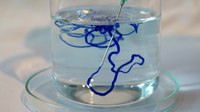
Photo from wikipedia
Cotton accounts for 30% of total fibre production worldwide with over 50% of cotton being used for apparel. In the process from cotton bud to finished textile product many steps… Click to show full abstract
Cotton accounts for 30% of total fibre production worldwide with over 50% of cotton being used for apparel. In the process from cotton bud to finished textile product many steps are required, and significant cotton waste is generated. Typically only 30% of pre consumer cotton is recycled. Here we use cotton waste lint to produce regenerated cellulose fibres (RCF). We find the RCF from waste cotton lint had increased mechanical properties compared to RCF produced from wood pulp. We show that this is likely linked to the higher degree of polymerization (DP) of waste cotton lint. An ionic liquid is used to dissolve the cotton lint and the rheology of the spinning is measured. The properties of the RCF are characterized and compared to wood pulp RCF.
Journal Title: Carbohydrate polymers
Year Published: 2017
Link to full text (if available)
Share on Social Media: Sign Up to like & get
recommendations!